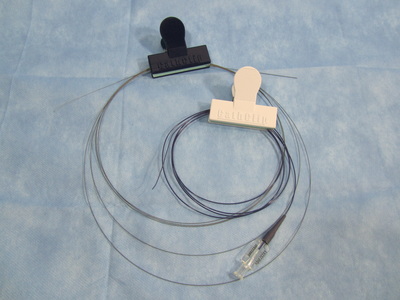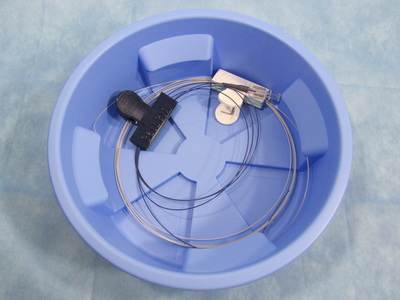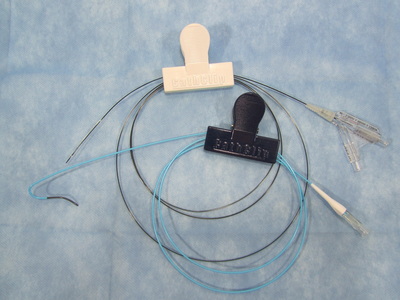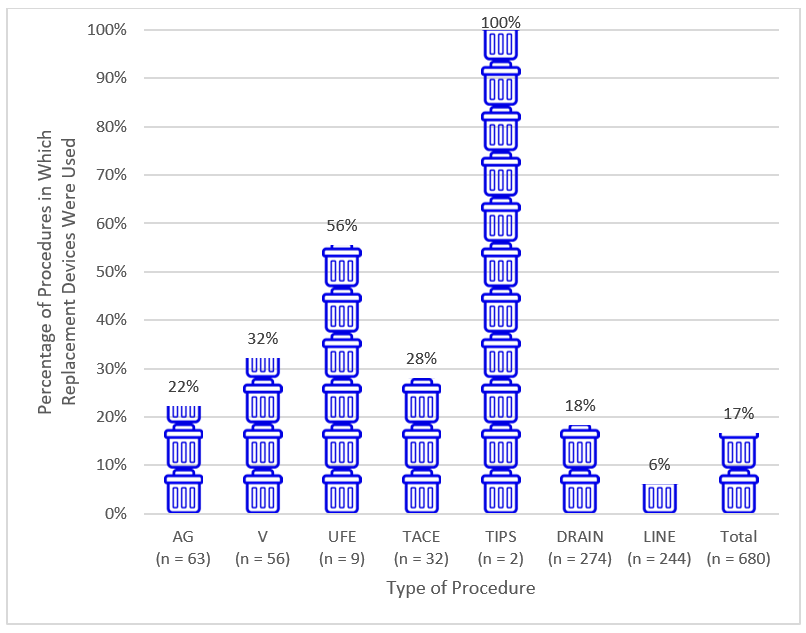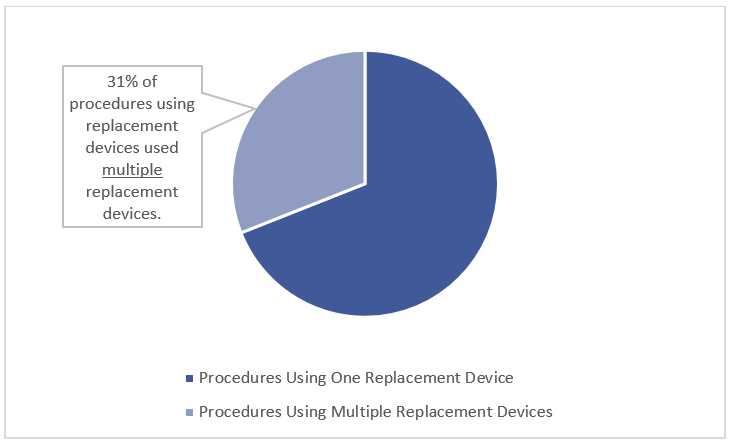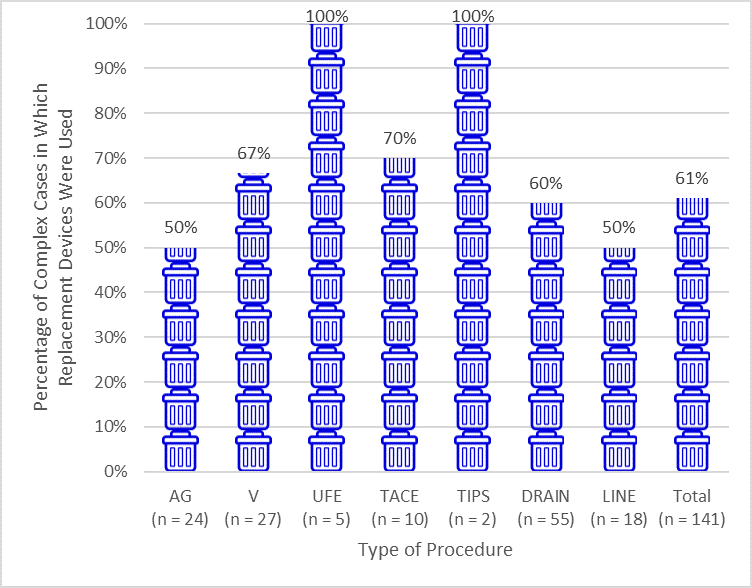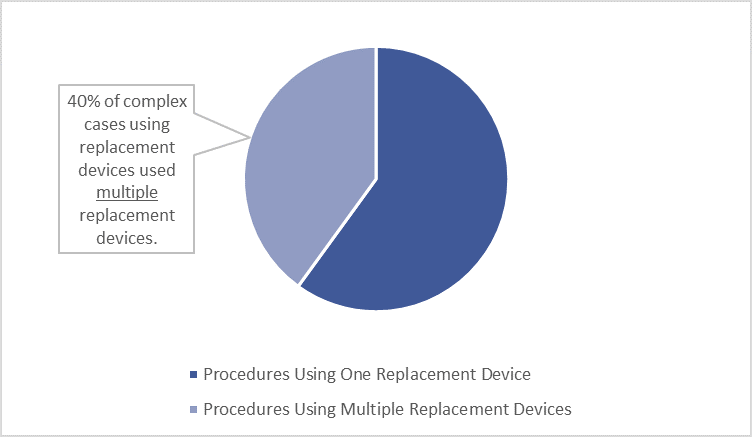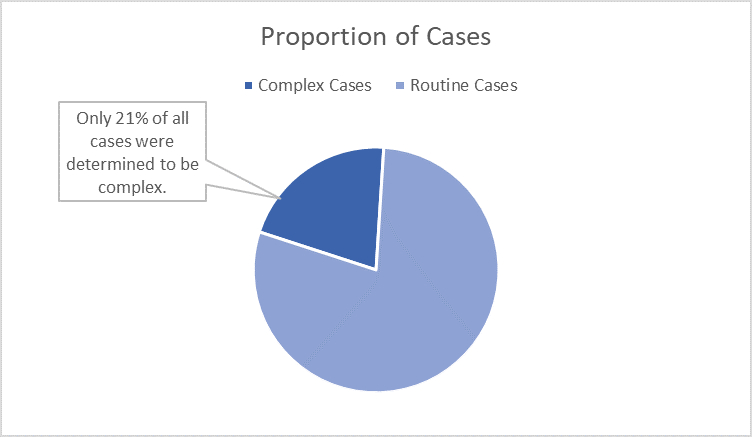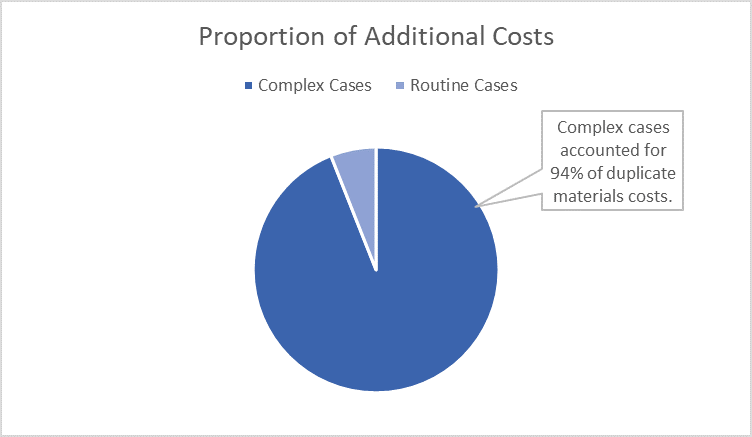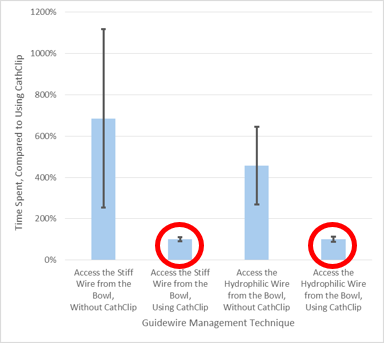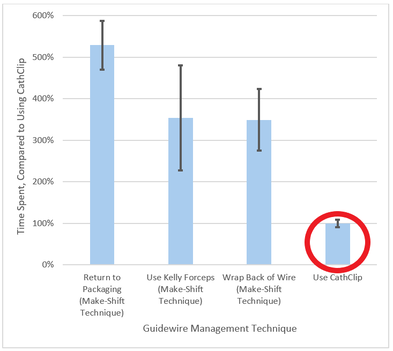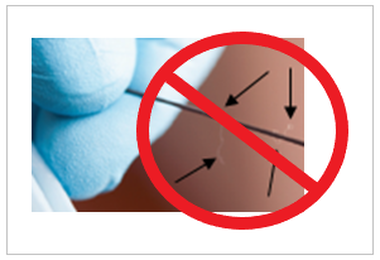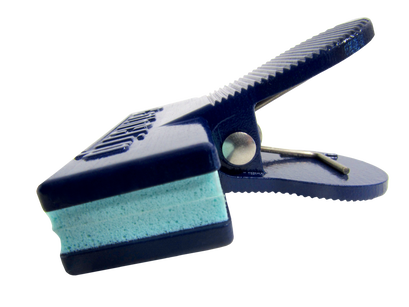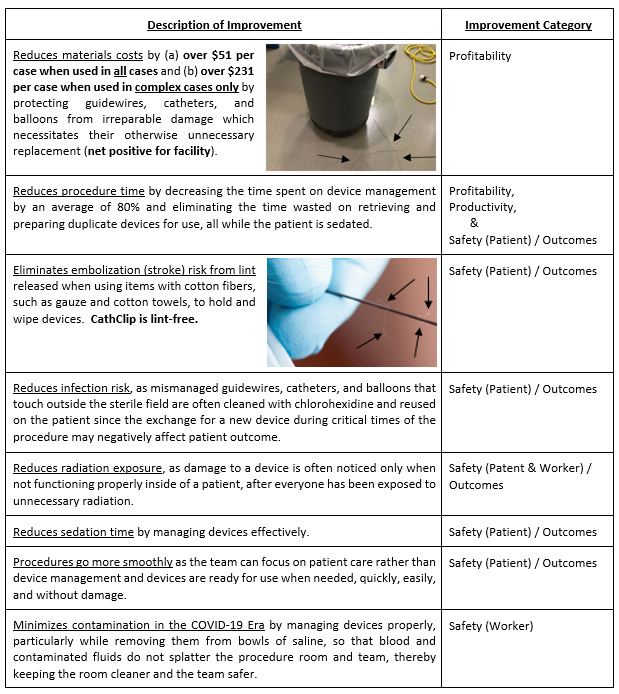The CathClip Solution:
Efficient & Reliable Device Management with One Simple Tool
A single, universal, lint-free device integrated within existing operator movements, CathClip solves the problem of mismanagement of flexible elongated medical devices (guidewires, catheters, balloons, etc.), leading to cost savings, improved safety, and improved clinical outcomes.
CathClip securely and gently holds any type of flexible elongated medical device, no matter what its particular characteristics are. The stiffest guidewires are held securely, the most fragile microwires are held damage-free, and hydrophilic wires are kept moist with CathClip's soft, hydrophilic, non-adherent gripping pads. CathClip is small, so many can fit in the sterile field and even in saline-filled bowls. CathClip's foam is a lint-free, dimensionally stable polyurethane which does not release lint, thereby eliminating the risk of intra- and post-procedure embolization due to lint.
Interventionalists and their procedure team members no longer need to waste time and energy on the management of flexible elongated medical devices - simply make a standard loop, clip on CathClip, and be assured that any device is cared for and ready for its next use during the procedure. Facilities benefit from CathClip's cost savings attributes, as it pays for itself in materials costs savings alone. Patients benefit from improved safety, as CathClip is lint-free, decreases contamination risk, and allows the care team to focus on patient care rather than device management.
CathClip securely and gently holds any type of flexible elongated medical device, no matter what its particular characteristics are. The stiffest guidewires are held securely, the most fragile microwires are held damage-free, and hydrophilic wires are kept moist with CathClip's soft, hydrophilic, non-adherent gripping pads. CathClip is small, so many can fit in the sterile field and even in saline-filled bowls. CathClip's foam is a lint-free, dimensionally stable polyurethane which does not release lint, thereby eliminating the risk of intra- and post-procedure embolization due to lint.
Interventionalists and their procedure team members no longer need to waste time and energy on the management of flexible elongated medical devices - simply make a standard loop, clip on CathClip, and be assured that any device is cared for and ready for its next use during the procedure. Facilities benefit from CathClip's cost savings attributes, as it pays for itself in materials costs savings alone. Patients benefit from improved safety, as CathClip is lint-free, decreases contamination risk, and allows the care team to focus on patient care rather than device management.
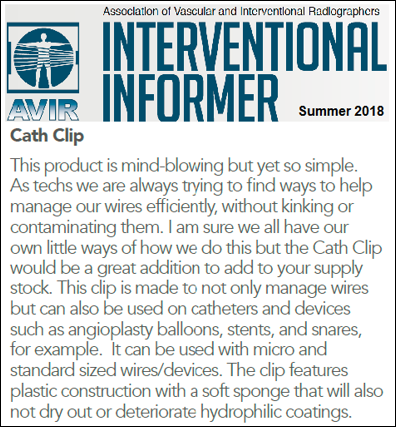
CathClip is the only universal, easily adopted, quick to use, and economical solution to holding any guidewire, catheter, or balloon between uses during procedures, safely and securely.
CathClip was designed by an Interventional Radiologist to integrate seamlessly with how flexible elongated medical devices are already handled in procedures now: once an elongated medical device is gently looped, it can be securely and gently held with CathClip's soft, hydrophilic, non-adherent, lint-free gripping pads.
After removing CathClip from its sterile packaging and dipping the gripping pads into saline, CathClip is ready to securely and gently hold any flexible elongated medical device - from the stiffest guidewires to the most fragile catheters and everything in between - with just a simple, easy clip.
CathClip comes in two colors (white & blue) - the different colors are to aid in organization only (there is no functional difference).
CathClip is lint free, thereby eliminating foreign material embolization (stroke) risk intra-procedure caused by holding and wiping devices with cotton fiber materials, such as gauze and cotton towels.
CathClip was designed by an Interventional Radiologist to integrate seamlessly with how flexible elongated medical devices are already handled in procedures now: once an elongated medical device is gently looped, it can be securely and gently held with CathClip's soft, hydrophilic, non-adherent, lint-free gripping pads.
After removing CathClip from its sterile packaging and dipping the gripping pads into saline, CathClip is ready to securely and gently hold any flexible elongated medical device - from the stiffest guidewires to the most fragile catheters and everything in between - with just a simple, easy clip.
CathClip comes in two colors (white & blue) - the different colors are to aid in organization only (there is no functional difference).
CathClip is lint free, thereby eliminating foreign material embolization (stroke) risk intra-procedure caused by holding and wiping devices with cotton fiber materials, such as gauze and cotton towels.
Using CathClip in every case pays for itself in materials cost savings alone and maximizes efficiency & safety benefits.
CathClip pays for itself in materials cost savings alone (no more duplicates, valued at over $51 per case in all cases and over $231 per case in complex cases), plus has additional benefits by further improving efficiencies (quicker, more reliable) and safety (decreases embolization/stroke and infection risk, procedure team focuses on patient care) - all while maintaining operational efficiency (just one product to manage any guidewire, catheter, or balloon).
Studies show that the cost of duplicate devices is over $51 per case in all cases in Interventional Radiology. This is an average which includes all cases, from the most simple to the most complex. Using CathClip can eliminate these duplicate devices and their associated costs. With 2-4 CathClips typically used in each case, CathClip pays for itself when used in every case.
In 31% of those procedures in which replacement devices were used, more than one (multiple) replacement devices were used, illustrating how the cost of replacement devices can add up quickly, thereby increasing costs and procedure duration. These devices often cost hundreds or even thousands of dollars each. The estimated $51 per case in additional materials costs due to duplicate devices was measured in all cases on average in one specialty only (Interventional Radiology) - the figure is likely to be higher if a different specialty is examined, such as Interventional Cardiology or Vascular Surgery, where more expensive devices, such as drug-eluting balloons and stents, are used.
Studies show that the cost of duplicate devices is over $51 per case in all cases in Interventional Radiology. This is an average which includes all cases, from the most simple to the most complex. Using CathClip can eliminate these duplicate devices and their associated costs. With 2-4 CathClips typically used in each case, CathClip pays for itself when used in every case.
In 31% of those procedures in which replacement devices were used, more than one (multiple) replacement devices were used, illustrating how the cost of replacement devices can add up quickly, thereby increasing costs and procedure duration. These devices often cost hundreds or even thousands of dollars each. The estimated $51 per case in additional materials costs due to duplicate devices was measured in all cases on average in one specialty only (Interventional Radiology) - the figure is likely to be higher if a different specialty is examined, such as Interventional Cardiology or Vascular Surgery, where more expensive devices, such as drug-eluting balloons and stents, are used.
Using CathClip in complex cases maximizes material cost savings.
Studies show that the incidence and therefore the cost of duplicate devices is greater in complex cases than in routine cases. While the cost of duplicate devices was over $51 in all cases (complex and routine), this extra cost was over $231 in complex cases only. As illustrated in the figures below, duplicate devices were used in 61% of complex cases, as compared to 17% of all cases, and in 40% of complex cases in which replacement devices were used, more than one (multiple) replacement devices were used.
While complex cases made up only 21% of all cases, complex cases accounted for 94% of replacement device materials costs.
CathClip is quicker & more reliable.
Studies show that using CathClip reduces time spent on device management in a typical procedure by 80%. CathClip also makes device management much more reliable and consistent, as illustrated by the standard deviations in the figures below. CathClip does what it claims, and user satisfaction scores are greater than 95%.
CathClip decreases COVID infection risk.
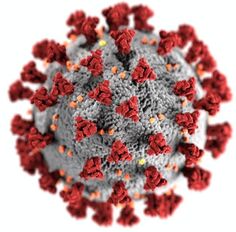
Minimizing contamination in the COVID-19 Era is an important CathClip safety benefit. Viable, infectious SARS-CoV has been isolated from respiratory, blood, urine, and stool specimens. Therefore, when a guidewire, catheter, or balloon is used on a patient, it has fluids on it that may contain SARS-CoV. When a device contaminated with SARS-CoV is placed in a bucket of saline, that saline is now likely contaminated with SARS-CoV. When guidewires, catheters, or balloons are removed from a bucket of saline with multiple such devices, those devices are often difficult to manage, and the saline often splashes - including on the care team and around the room. Therefore, if that saline is contaminated with SARS-CoV, SARS-CoV has now splashed on the care team and around the room, increasing COVID exposure. Using CathClip effectively controls guidewires, catheters, and balloons so that they can be removed from a bucket of saline without splashing, thereby decreasing exposure when such saline is contaminated with SARS-CoV. Universal and easy to use, CathClip controls guidewires, catheters, balloons, and other similar devices during procedures, between uses. Using CathClip minimizes contamination, keeping the procedure room cleaner and the procedure team safer.
CathClip is a simple, low cost addition that helps protect from COVID exposure, which is a huge risk - the cost-benefit analysis is favorable to using CathClip (plus it saves on materials costs and pays for itself, as detailed above).
CathClip is a simple, low cost addition that helps protect from COVID exposure, which is a huge risk - the cost-benefit analysis is favorable to using CathClip (plus it saves on materials costs and pays for itself, as detailed above).
CathClip is lint free.
Holding and wiping guidewires, catheters, balloons, and other similar devices with materials with cotton fibers, such as gauze and cotton towels, increases the risk of complications from lint, such as embolization (stroke). See, e.g., Fischi M and Narins CR. Coronary Embolization of a Gauze Fragment: A Cautionary Case Report. Catheterization and Cardiovascular Interventions (2005). Vol. 66, 570-572. Citations to additional academic articles on this safety issue are included in the CathClip New Product Justification / Value Analysis, available for download below.
Low-lint towels do not hold these devices as well as the materials they have replaced and are not lint free. CathClip's foam is a dimensionally stable polyurethane which does not release lint, thereby eliminating the embolization/stoke risk presented by lint, and CathClip holds any guidewire, catheter, or balloon, reliably, securely, and safety.
Low-lint towels do not hold these devices as well as the materials they have replaced and are not lint free. CathClip's foam is a dimensionally stable polyurethane which does not release lint, thereby eliminating the embolization/stoke risk presented by lint, and CathClip holds any guidewire, catheter, or balloon, reliably, securely, and safety.
CathClip is UNIVERSAL - only ONE product is needed to save costs, increase safety, & achieve better outcomes in all procedures that use guidewires, catheters, balloons, & other similar flexible elongated devices.
There is no need to stock multiple different wire management devices for different specialties or different flexible elongated devices.
With its universal force strength and foam gripping pads, CathClip securely and gently holds any flexible elongated device, no matter its particular characteristics. This includes stiff wires, hydrophilic wires, balloons, diagnostic catheters, and fragile and highly expensive microwires and microcatheters.
Using CathClip in all procedures in which flexible elongated medical devices are used reduces costs, improves safety, and improves outcomes.
This includes procedures in the following specialties:
With its universal force strength and foam gripping pads, CathClip securely and gently holds any flexible elongated device, no matter its particular characteristics. This includes stiff wires, hydrophilic wires, balloons, diagnostic catheters, and fragile and highly expensive microwires and microcatheters.
Using CathClip in all procedures in which flexible elongated medical devices are used reduces costs, improves safety, and improves outcomes.
This includes procedures in the following specialties:
- Cardiothoracic Surgery
- Gastroenterology
- Interventional Cardiology
- Interventional Nephrology
- Interventional Neuroradiology
- Interventional Pulmonology
- Interventional Radiology
- Urology
- Vascular Surgery
Summary of CathClip Benefits
Using CathClip solves the problems caused by mismanagement of devices, improving procedure profitability, productivity, safety, and clinical outcomes, including as described below.
CathClip Sales Flyer
A sales flyer describing CathClip's features and benefits of increased profitability, productivity, and safety is available for download directly below.
| CathClip Sales Flyer | |
| File Size: | 549 kb |
| File Type: | |
CathClip New Product Justification / Value Analysis
An introduction to CathClip with details of its benefits to cost savings, safety (patient and worker), and clinical outcomes, including relevant white papers and citations to relevant academic articles, is available for download directly below.
| CathClip New Product Justification and Value Analysis | |
| File Size: | 2900 kb |
| File Type: | |

